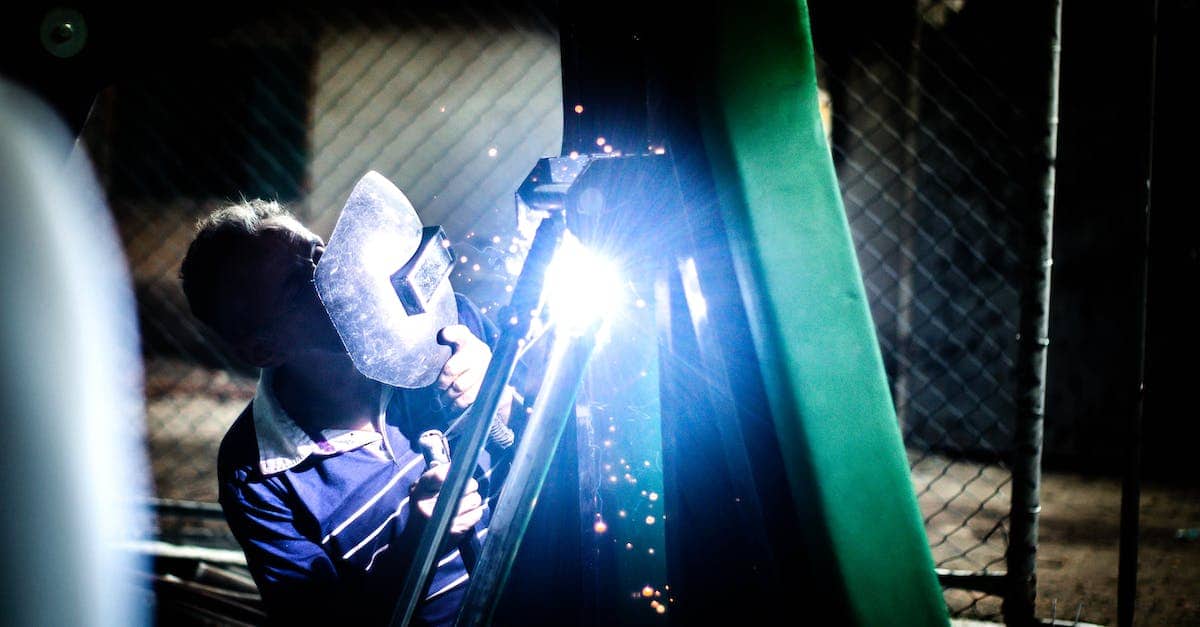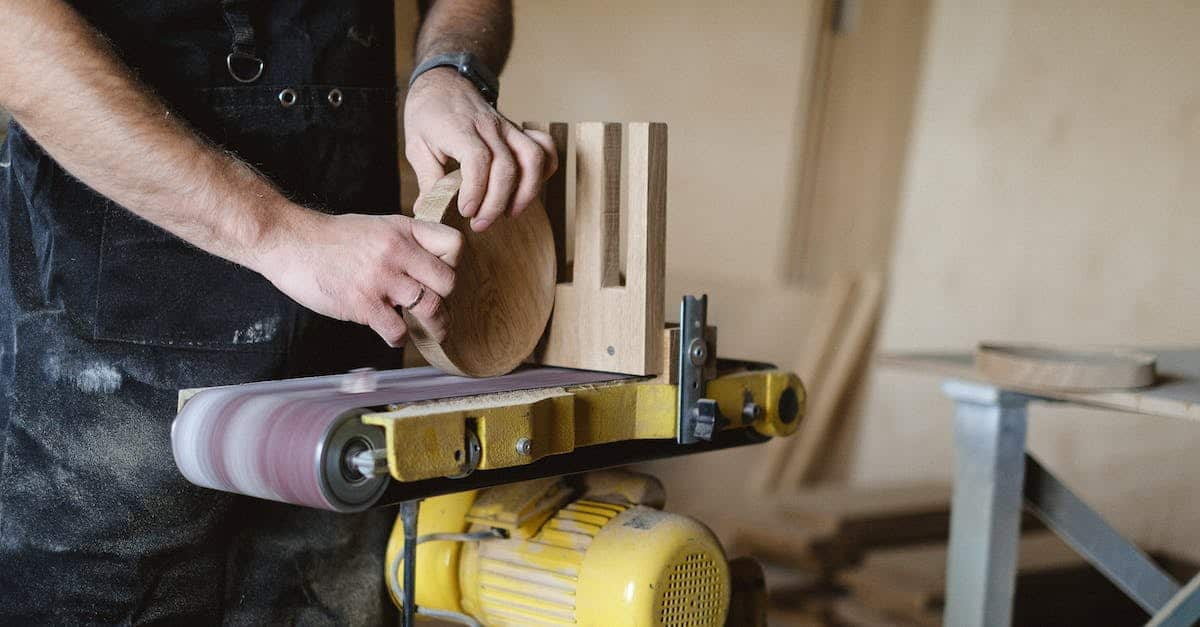Ever wondered how to tackle those tough cutting and grinding jobs with ease? Well, you’re in luck! An angle grinder might just be the tool you need. It’s versatile, powerful, and can make your DIY projects a whole lot easier.
Safety Precautions When Using an Angle Grinder
When working on your latest piece in the workshop, there’s a sense of pride that comes with every cut and grind. But remember, your safety is the top priority. An angle grinder is no toy and mishandling it can lead to serious injuries. Here’s how you keep safe while using this powerful tool.
Always Wear Protective Gear
The first rule of any DIY project, especially when it involves an angle grinder, is to suit up with the proper safety equipment:
- Safety goggles or a face shield to protect your eyes from flying debris
- Hearing protection to shield your ears from the high decibel grinding
- Thick work gloves to safeguard your hands against sparks and sharp edges
- A dust mask or respirator to avoid inhaling dust and particulates
Inspect Your Equipment
Before powering on your angle grinder, give it a thorough check:
- Ensure the disc is secured correctly and is suited for the material you’re cutting.
- Double-check that the guard is in place and properly adjusted.
- Inspect the power cord for any damage.
Maintain a Secure Environment
Keep your workspace clean and clutter-free. Secure loose clothing and tie back long hair to prevent any entanglement with the spinning disc. Remember:
- Always use the side handle for better control and stability.
- Keep a firm grip and maintain balance at all times.
- Never operate the grinder without the guard properly installed.
Operate with Care
when you start your angle grinder, let the tool reach its full speed before contacting the material:
- Approach your workpiece at the correct angle, typically a 90-degree position.
- Don’t apply excessive pressure; let the tool do the work.
- Switch off and unplug the grinder when changing accessories or not in use.
Sticking to these guidelines will ensure that your creative journey in woodworking stays as risk-free as possible. Remember, taking the time to prep and proceed with caution isn’t just about following rules; it’s about respecting the craft and the tools that make it all happen.
Choosing the Right Angle Grinder for the Job
When you’re ready to select an angle grinder for your woodworking projects, it’s not just about grabbing any tool off the shelf. The right grinder makes all the difference.
First, consider the size of the grinder. Angle grinders are typically available in disc sizes ranging from 4-1/2 inches to 9 inches. For most of your woodworking tasks, a 4-1/2 inch grinder is agile enough for precise work but still powerful enough for most materials you’ll encounter.
Next, think about the motor power, expressed in amperages for electric grinders. For cordless options, focus on the battery’s voltage and amp-hours (Ah). Higher numbers usually mean more power and runtime, but also a heavier tool. For everyday use, a corded grinder with a motor that draws around 6 to 7 amps should suffice.
Power Source is Key – Corded grinders offer a dependable power supply with no worries about charging batteries. In contrast, cordless models offer unparalleled portability and convenience, which is invaluable if you’re not always close to a power outlet.
Consider features that enhance safety and ease of use:
- Paddle switch or trigger
- Adjustable side handle
- Quick-change disc system
- Variable speed control
| Feature | Benefit |
|---|---|
| Paddle Switch | Prevents accidental start-ups |
| Adjustable Side Handle | Improves control and balance |
| Quick-Change Disc | Allows for rapid disc replacement |
| Variable Speed | Matches speed to the application for better precision |
When it comes to Brand and Build Quality, investing a little more in a reputable brand can pay off in longevity and performance. It’s also worthwhile to check if the model smoothes edges efficiently since you’ll want seamless joins in your wood projects.
Lastly, check user reviews and woodworking forums. Fellow enthusiasts often share which grinders stand up best to the rigors of continuous use, and that’s invaluable intel that can guide your purchase. Remember, it’s all about how the tool feels in your hands and integrates into your workflow. Choose wisely and your angle grinder will become as pivotal to your craft as the wood itself.
Understanding the Different Types of Angle Grinder Discs
When you’re delving into woodworking projects, the right angle grinder disc can make all the difference. Each disc type has its specific purpose, and choosing the wrong one can lead to wasted time and a less-than-desirable finish on your project. It’s like picking the right chisel for intricate carving—precision matters.
Cut-off discs are thin and mainly used for cutting through material. They’re your go-to for slicing through metal brackets or trimming down nails and screws that are sticking out. But for woodworking, you’ll generally put these aside for more specialized discs.
Grinding discs come in handy for smoothing out welds or rough metal edges if you’re incorporating metal in your wood designs. The grit level will tell you how coarse the disc is—the lower the number, the coarser the disc. For finer work, you’ll want a higher grit level.
When it comes to working directly with wood, flap discs are where it’s at. These have overlapping layers of sandpaper and are perfect for sanding down wood. They’re like having a power sander attached to your angle grinder and can remove material quickly or give you a nice, smooth finish, depending on the grit you choose.
Then there’s the carving discs. These are exceptional for shaping wood and can sculpt, bevel, and hollow out areas with a finesse that’s tough to achieve with other tools. It’s almost like wielding a potter’s wheel; you can shape your workpiece with a fluidity that feels almost artistic.
Lastly, diamond-tipped discs are the heavy hitters. Originally designed for cutting through concrete and stone, these can be used for intricate woodworking tasks like inlays or dealing with extremely hard woods.
| Disc Type | Purpose | Woodworking Uses |
|---|---|---|
| Cut-off Discs | Cutting through material | Trimming nails, screws |
| Grinding Discs | Smoothing out welds or rough metal edges | Preparing metal elements in wood designs |
| Flap Discs | Sanding down wood | Quick removal, smooth finishes |
| Carving Discs | Shaping wood | Sculpting, beveling, hollowing |
| Diamond-tipped | Cutting through concrete, stone, hard materials | Inlays, hard wood detailing |
Setting up Your Work Area for Angle Grinding
Before you dive into your next woodworking project with an angle grinder, it’s vital to set up your work area properly. Not only will this ensure your safety, but it’ll also make your work more efficient and enjoyable.
First, designate a work zone that’s well-ventilated. Angle grinding can produce a lot of dust, and you don’t want to breathe that in. If you’re working indoors, open windows or set up a fan to blow dust away from you. For outdoor projects, position yourself upwind if you can.
Next, clear the area of unnecessary clutter. You need a spacious surface to maneuver your material and your tools. Make sure there’s ample room around your workbench or the area where you’ll be grinding to move freely without tripping over anything.
Safety is paramount when using any power tool. Before you start grinding, equip yourself with the necessary protective gear:
- Safety glasses or goggles to shield your eyes from flying debris
- Ear protection to guard against the noise from the grinder
- A dust mask or respirator to avoid inhaling sawdust and grit
- Tough, durable work gloves to protect your fingers and improve grip
Once you’ve got your safety gear on, secure the material you’ll be working on. If it’s a smaller piece, clamp it down to your workbench to prevent it from moving. For larger items that can’t be clamped, make sure they’re weighted down or supported adequately so they won’t shift while you work.
Lastly, check that your angle grinder is in good working order. Inspect the power cord for any damage and ensure the disc you’ve chosen for your task – be it a cut-off, grinding, flap, carving, or diamond-tipped disc – is correctly attached and appropriate for the material you’re working with.
With your work area set up and your safety gear in place, you’ll be ready to tackle your woodworking projects with confidence and precision. Keep focused, work steadily, and remember to take regular breaks to rest and assess your progress.
Using an Angle Grinder to Cut Metal
When you’re ready to dive into your woodworking project that involves metal parts, grabbing your angle grinder can be a game-changer. But before you start slicing through metal like butter, there are a few things that’ll make the process smoother and safer.
First off, choose the right disc. You’ll want a disc that’s labeled for cutting metal. It’ll be thin, about 1/16-inch, which reduces resistance and heat build-up. Ensure it’s securely attached and rated for the speed of your grinder.
Measure and mark the metal where you need to cut. Using a metal scribe is best – it’s like your project’s roadmap. Don protective gear, and don’t forget hearing protection, as cutting metal can get loud. Position yourself to the side of the cut line to minimize exposure to sparks and debris.
Maintain steady pressure and let the tool do the work. Don’t force it—forcing can overheat the disc and the metal, leading to warping and potential disc failure. If the disc starts to turn red, ease up a bit. A slow and steady cut will give you a cleaner line.
Keep your movements smooth. Jerky moves can bind the disc, leading to kickback, which can be dangerous. If you need to stop, don’t pull the disc out while it’s still spinning. Let it come to a complete stop within the cut to avoid a jagged edge or damaging the disc.
Remember to check for heat build-up. If the metal gets too hot, pause to let it cool. Overheated metal can change its properties and become harder to cut, potentially damaging your disc or altering the integrity of the metal.
Periodically wipe away the metal filings; they can accumulate and become a safety hazard. A simple metal brush can keep your work area and the cut line clean, reducing the risk of accidents and ensuring precision in your work.
Cutting metal might seem like it’s outside your woodworking wheelhouse, but with these strategies, you’ll see it’s just another way to elevate your projects. It adds a robust dimension to your creations, and mastering the use of an angle grinder on metal gives you a well-rounded skill set in your DIY arsenal. Just remember to take it slow, and you’ll be cutting metal with confidence in no time.
Grinding and Sanding with an Angle Grinder
After you’ve mastered cutting metal with your angle grinder, it’s time to dive into grinding and sanding, where this versatile tool really shines in your woodworking projects. Grinding removes excess material or smoothens out surfaces while sanding is ideal for getting that perfect finish.
Select the Appropriate Discs – Just like with cutting, the right disc is crucial for effective grinding and sanding:
- Use a grinding disc for metal or hard materials.
- For wood, grab a flap disc which is less aggressive and better suited for creating a smoother surface.
Safety First – Always remember to wear your safety gear. Eye protection, earplugs, and a dust mask are non-negotiable.
Control Your Tool – Keep your movements steady. Start with a low pressure to get a feel for how the disc behaves against the wood and increase pressure gradually as you become more comfortable.
- Avoid pressing too hard; let the tool do the work.
- Move in continuous motions to prevent gouging.
Frequent Inspections – Regularly check the surface you’re working on:
- Look for any signs of burning or unexpected wear patterns.
- Ensure you’re achieving the desired level of smoothness.
Dust Management – Dust and debris are inevitable when grinding or sanding:
- Connect your angle grinder to a shop vacuum when possible.
- Take breaks to clear away residual dust.
As you alternate between grinding and sanding, you’ll notice your project transforming. The shapes become more defined, the surfaces smoother, and those once rough edges begin to blend seamlessly into your woodworking masterpiece. With a bit of patience and practice, your angle grinder could become one of the most valuable tools in your woodworking arsenal. Remember, it’s not about the destination but the journey of crafting something beautiful with your own hands. Keep refining those skills, and you’ll be amazed at the versatility an angle grinder brings to your projects.
Maintaining and Cleaning Your Angle Grinder
Maintaining your angle grinder is just as important as knowing how to use it. Without regular upkeep, you’ll find its performance lackluster and its lifespan significantly shortened.
First off, make sure to unplug the tool or remove its battery before you begin any maintenance. Safety should always be your top priority. Begin by brushing off any sawdust or debris on the grinder with a soft-bristled brush. This prevents buildup which can clog up the motor vents, leading to overheating.
Next, take a moment to inspect the power cord for any signs of wear or damage. A frayed cord is not just ineffective, it’s hazardous. Moving parts require attention too. Check the tightness of the disc flange before and after use, ensuring it’s securely fastened.
Turning to the inner workings, blow out any residual dust from inside the grinder using compressed air. This step is crucial; fine wood dust can settle inside your tool, impeding its function. If you’ve been working with resinous woods or materials that can gum up your grinder, using a damp cloth can help remove any sticky substances. Just make sure the grinder is dry before its next use.
For the parts you touch, like the handle and the outer casing, a simple wipe-down with a damp cloth will do. Over time, grime from your hands can cause extra wear on these surfaces or make the tool uncomfortable to hold.
Finally, examine the brushes inside the motor through the inspection ports. These need to be long enough to maintain contact with the motor, or they’ll need replacing. It’s a simple process and a quick inspection can prevent unexpected downtime.
Remember to pop a reminder on your work calendar for a thorough clean after a heavy project, or at regular intervals if your woodworking endeavors are more frequent. Your angle grinder’s longevity will thank you for it.
Conclusion
Armed with these tips, you’re now ready to keep your angle grinder in top condition. Remember, a little effort goes a long way in preserving your tool’s performance and safety. Stick to a regular cleaning routine and you’ll find your grinder always ready for the next job. Happy grinding!
Frequently Asked Questions
What is the best way to maintain an angle grinder?
Regular maintenance, including brushing off debris, checking the power cord and disc flange for wear, blowing out dust from internal components, removing sticky residues, and wiping down exterior surfaces, is essential for optimal angle grinder performance.
How often should an angle grinder be cleaned?
An angle grinder should be cleaned regularly, with a thorough inspection and cleaning scheduled based on the frequency of use. For heavy use, clean the grinder after each use; for less frequent use, clean it after each project or monthly.
Can I clean the angle grinder’s motor brushes myself?
Yes, you can clean the motor brushes yourself. Make sure the grinder is unplugged, access the brushes following the manufacturer’s instructions, and gently remove any dust or debris from the brushes and brush holders.
What should I do if the power cord is damaged?
If the power cord shows signs of wear or damage, it’s essential to replace it or have it repaired by a professional to prevent electrical hazards. Do not continue to use the angle grinder with a damaged cord.
Why is it important to maintain an angle grinder?
Maintaining an angle grinder is crucial for safe operation, ensuring the tool works efficiently, and for extending its lifespan. Proper upkeep prevents malfunctions and potential safety hazards related to tool failure.




